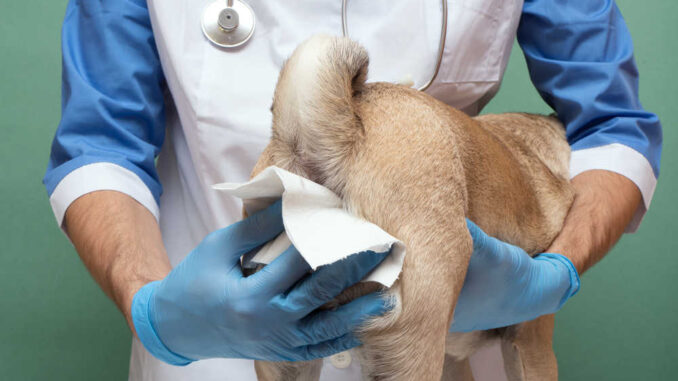
This article was updated on September 17th, 2023
When I had a call from a client because his dog had blood and pus oozing from his butt, I told him to bring her in right away. A brief history and examination confirmed my suspicions, she had a ruptured anal gland.
What are anal glands and what does it mean when they rupture? I’ll answer that question and explain the treatment options and recovery process. To help you care for your furbaby, I’ll suggest some things you can do at home before and after visiting the vet. Before we finish, we’ll also go over the causes, symptoms, and diagnosis of ruptured anal glands.
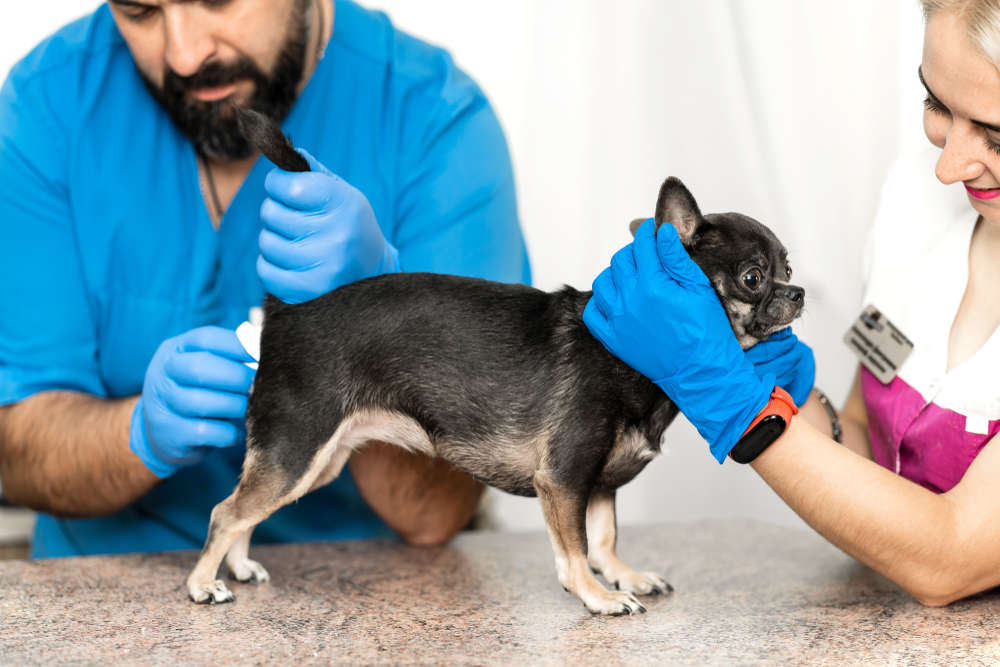
What does it mean when an “anal gland” ruptures?
Before we explain ruptures, let’s briefly go over what anal glands are and the purpose they serve for your dog. All canines have modified sweat glands in the muscle layers of their rectum. These glands secrete an oily, smelly liquid that helps lubricate your dog’s poop, marks territory, and leaves a scent signature for communication.
Typically, your dog naturally expresses his anal glands when he defecates. But if the sacs don’t empty for some reason, the fluid continues to accumulate, and it thickens. The stagnant liquid provides a breeding ground for bacteria, so blocked anal glands often become infected. Over time, the gland can become abscessed. As the fluid pressure builds, the abscess eventually breaks open, or ruptures.
Ruptured anal glands require immediate treatment. If they’re left to fester, the infection can spread and may cause damage to the anus and rectum.
What are the treatment options and likely cost for anal gland rupture in dogs?
When your dog has an anal gland abscess that ruptures, your veterinarian will:
- Lance intact abscesses and drain any remaining pus from the gland
- Flush the gland and ducts with an antibiotic or antiseptic solution
- Prescribe oral antibiotics and pain/anti-inflammatory medications
The cost of draining and flushing ruptured anal sacs will run approximately $100 if there are no complications. 10-14 days of antibiotics and pain medications for a rupture should cost around $50-75.
If the infection is severe or has spread after the gland ruptures, surgery may be required to remove the anal glands and debride affected tissues. The cost of treatment including preliminary bloodwork, anesthesia, surgery, and aftercare can run about $750-2500.
What is the recovery and healing process like after veterinary treatment?
Anal sac ruptures look horrendous and can be deeply concerning to dog owners. Fortunately, with prompt treatment, the prognosis for a full recovery is excellent, and the healing process should take about 10-14 days provided you give your dog the full course of antibiotics, and the infection clears up.
Within a few days after treatment, your dog should return to normal pooping. If he wants to lick the area, you may need to use an e-collar. The site will be itchy, and your dog may scoot. This will knock off any scabbing and leave a gaping hole. Don’t be alarmed, it’s normal.
The fistula will actually allow any fluid to drain and prevent reinfection. You may want to place towels under your dog when they sleep or rest. Within about a week, the medications will reduce inflammation in the area, and the hole will heal.
How can you help your dog at home?
If you notice your dog starting to scoot his butt across the floor or turning to look at his bottom, he may have impacted or infected glands. Check the area for signs of redness, pain, or swelling. When you suspect there’s an issue:
- Don’t attempt to manually express your dog’s glands. You may do more harm than good.
- Call your veterinarian and schedule an examination
- Gently apply warm compresses to the anus to help open the anal gland ducts and ease your furbaby’s discomfort.
Sometimes, infected anal glands will abscess and rupture before you reach the veterinarian. When this occurs, do the following at home until you can get to the doctor:
- Prevent your dog from licking the area. Use an e-collar if needed.
- Keep the area around the rupture clean after your dog goes to the bathroom. Use moistened sterile gauze pads to gently wipe the area around the hole.
- Try to keep your dog from scooting.
- Provide clean towels for your dog to sleep and rest.
What causes anal gland rupture in dogs?
When a dog’s anal glands are blocked, the fluid collects inside the sacs, thickens, and becomes stagnant. Normally, bacteria or other contaminants flush from the ducts when your pup naturally expresses his glands. When there’s no fluid passing through the channels, bacteria can travel backward from the rectum through the ducts into the glands. This leads to an infection.
Infection and abscess are the cause of eventual anal gland rupture in dogs. As the bacteria multiply, and fluid continues to collect, the sacs swell and become reddened and painful. Without treatment, they will continue to expand until they rupture.
If your dog has infected glands, he may hasten their rupture through self-trauma(biting the anus or scooting on the ground) or straining during defecation.
You may notice the following symptoms if your dog has infected anal glands.
- Scooting
- Red, swollen butt
- Quickly turning to lick his butt
- Straining to poop
- Pain or vocalization during defecation
- Blood or pus discharge around the anus
- Fishy odor
- Whining
Dogs with infected or ruptured anal glands need veterinary treatment. The doctor can prescribe an appropriate antibiotic and painkillers/anti-inflammatory drugs to help your dog heal. While you’re waiting for the appointment, keep your dog’s rear end clean and prevent him from licking, chewing, or scooting.
Symptoms of anal gland ruptures in dogs
When dogs have an abscessed anal gland that ruptures, you may notice:
- Swelling with red-purple discoloration prior to rupture.
- A bloody brown or yellow-green (pus) discharge around the anus.
- A foul, fishy odor.
- An open wound around the anus (View this picture from Canine Journal).
- Painful defecation during the abscess phase that is significantly less after a rupture occurs.
- Attempting to lick the rear or scoot.
The picture below shows an anal gland abscess (swelling to the left of the anus) which has ruptured. The skin is bruised and inflamed and there is notable swelling. When these lesions rupture, we see bloody discharge containing pus and there can be a foul smell. The fur around it will become crusted.
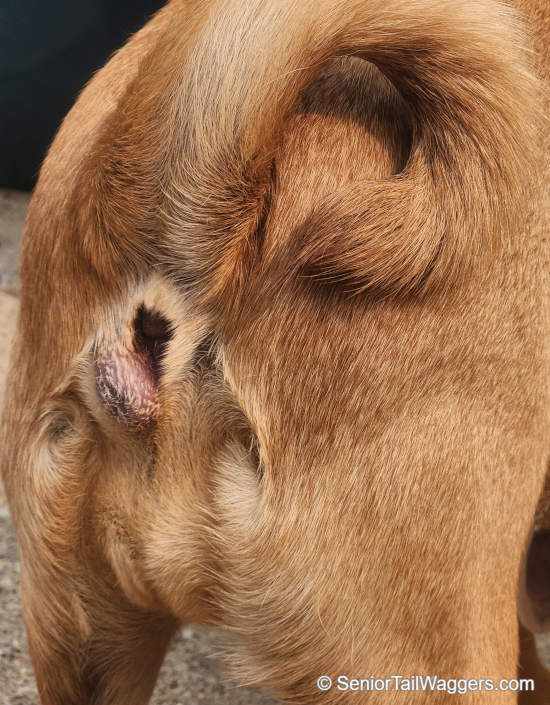
How is an anal gland rupture in dogs diagnosed?
If your dog shows signs of an anal gland rupture, take him to the veterinarian. The diagnosis is fairly straightforward, but your doctor will perform a complete physical examination.
In addition to confirming the rupture, your vet will assess the wound and determine whether the abscess has fully ruptured. If the pus pocket is intact and requires lancing, the doctor may check bloodwork prior to sedating your dog.
When should I visit the vet?
Abscessed and ruptured anal glands need treatment to heal the infection. Therefore, schedule an appointment with your veterinarian any time you notice
- red or purple-red swelling around the anus
- Pus or blood drainage around the rectum
- Blood on your dog’s stool
- Scooting
- Excessive licking/chewing in the anal area
- An open wound around the anus
Frequently asked questions
Is surgery always necessary for anal gland rupture?
If your dog’s anal gland ruptures and the pus fully drains from the open abscess, surgery is probably not necessary. Your dog will require surgical lancing if there is an intact abscess. Veterinarians usually do not suture the rupture wound so that the wound can continue to drain as it heals.
How long does it take a dog to recover from anal gland rupture?
As long as there are no complications, most dogs recover from ruptured anal glands in about 10-14 days. Dogs should start to feel better in around 2-3 days after the rupture is drained and flushed and treatment begins.
Are there any complications or risks associated with treatment?
Most anal gland ruptures respond well to treatment and heal completely. During the healing process, it’s important to prevent your dog from licking the wound because it can delay recovery and may reintroduce infection to the wound. Additionally, you should discourage your furbaby from scooting which can reinjure the wound and delay healing.
Can anal gland rupture be prevented?
Anal gland rupture is often preventable in dogs.
- Feed your dog a fiber-rich diet to encourage healthy digestion and firm stools for natural anal gland expression
- Keep your dog fit and trim to prevent fat buildup in the anus
- If your dog is at risk for blocked anal glands, schedule regular vet checks to express full sacs if needed. Leave expression to your veterinarian unless the doctor instructs you on the proper procedure and advises you to do it at home.
Related posts:
Disclaimer: This website's content is not a substitute for veterinary care. Always consult with your veterinarian for healthcare decisions. Read More.


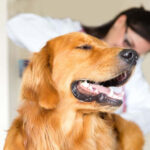
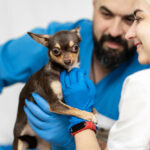
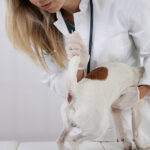
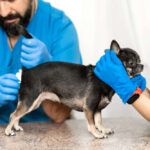
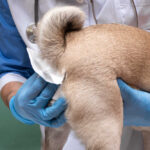
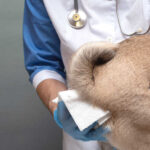
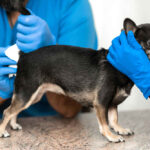

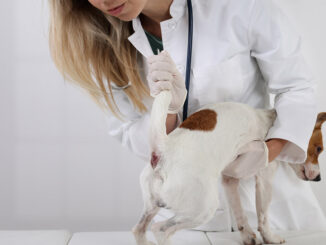
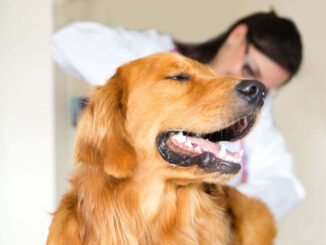
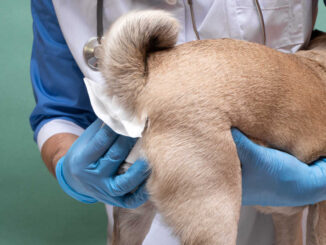
Be the first to comment